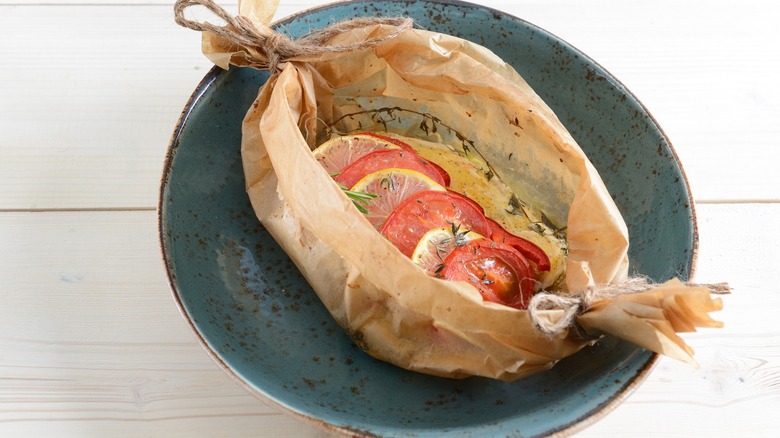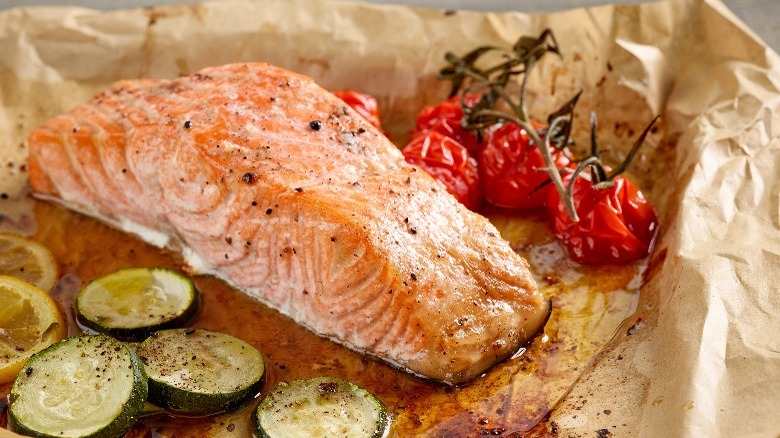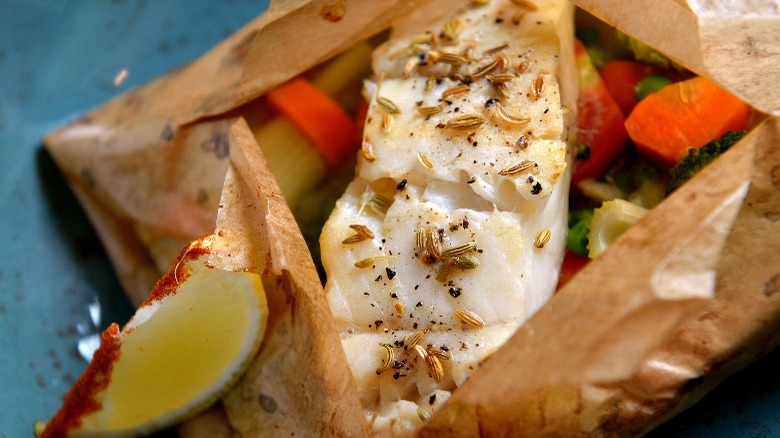What Is Cooking 'En Papillote' And How Does It Work?
Quick, healthful, and delicious — and with minimal clean-up! — cooking en papillote is an easy and practical cooking technique, useful in any cook's arsenal no matter your level of cooking expertise. So what exactly is en papillote? Despite the romantic mystique that the French language imbues everything with, "en papillote" simply means baking "in paper," aka cooking in parchment paper or foil. And while this cooking method is easy to do, the presentation and flavor results will make you look like a master chef in your own kitchen.
That's because, en papillote cooking traps moisture and flavor inside a tightly sealed pouch, steaming food to tender, juicy perfection and is an excellent choice for cooking light proteins such as fish (the classic version), shrimp, thinly-sliced chicken cutlets, and even firm tofu. Combine your protein with some quick-steam veggies such as sliced peppers, onions, peas, corn, tomatoes, and mushrooms and you've got a whole serving of dinner in one nifty packet.
Fun and uncomplicated, this no-muss-no-fuss cooking method also offers a lot of opportunities for creativity and experimentation.
Preparing to cook en papillote
The first thing you'll want to do when cooking en papillote is to preheat your oven to the desired temperature based on the protein you've chosen. One word of caution though, be sure not to exceed 450 degrees Fahrenheit, as parchment paper can catch fire at temperatures higher than that. (Those who've read Ray Bradbury already knew that.)
Next, prepare your parchment paper (or aluminum foil) by cutting or tearing off a large piece, roughly 14 inches by 12 inches, or large enough to hold one serving, with some room left along the edges. Fold the paper in half down the middle or on the diagonal, making a crease. Ready as many sheets of cooking paper as required for each serving you'll bake. When you've got the number of packets you'll need, unfold the parchment paper on a flat surface. It's now ready for the filling.
Cooking en papillote
Once the parchment paper is ready, lay your protein in the center of it. Next, add vegetables, fruits, or herbs to top the protein. With en papillote, the goal is that everything finishes cooking simultaneously, so choose veggies that cook quickly, such as asparagus, long slim carrots, thin lemon slices, or cherry tomatoes.
Want to add potatoes? You can thin-slice them on a mandolin or par-cook any thick-cut veggies, allowing them to finish in the packet. Once your protein and veggies are neatly piled, add some fresh herbs and spices. Finish with a drizzle of oil, a pad of butter, or a splash of wine for greater depth of flavor.
Seal the packet on all sides, neatly folding the paper around itself sort of like a dumpling — beginning at the point if your fold is on the diagonal, at the corner if making a rectangle packet, or at the top and bottom if making a candy twist. When you're finished, the packet should be sealed tightly, with no gaps, keeping the steam in. Finally, lay the packets on a sheet pan and place them in the oven. (Foil versions can go directly on the oven rack or on an outdoor grill.)
Cooking times vary but you'll know it's done when the packet has puffed up and changed color, darkening in hue. To serve, simply place the packet on a plate, and cut a slit down the middle, allowing the paper to open up, exposing the tasty food inside — a grand unveiling worthy of its fancy name.


